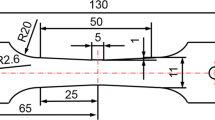Abstract
The springback-free mechanism in hot stamping of ultra-high-strength steel parts was clarified by the mechanical, thermal and transformation viewpoints. In hot stamping, the effects of elastic recovery during unloading and thermal shrinkage on the springback are comparatively small, but the effect of the phase transformation is critical. Volume expansion occurs primarily upon the start of the martensitic transformation, and plastic deformation is induced by the volume expansion during holding at the bottom dead centre, causing the springback including the post-stamping deformation to disappear. It was observed from well-organised experiments that holding at the bottom dead centre until the martensite finish temperature prevents the springback, and the springback-free mechanism in hot stamping of ultra-high-strength steel parts was clarified from the observation. The springback behaviour in hot stamping of a thin steel sheet with 0.6 mm thickness was explained from the above mechanism, and the deformation behaviour and quenchability for the thin sheet were examined. A sufficient holding time at the bottom dead centre was more closely associated with the prevention of springback rather than sufficient hardening. Additionally, local thinning around the bottom corner of a bent thin sheet was prevented by optimising the transfer time from the furnace.
Similar content being viewed by others
References
Åkerström P, Oldenburg M (2006) Austenite decomposition during press hardening of a boron steel—computer simulation and test. J Mater Process Technol 174(1–3):399–406
Mori K, Bariani PF, Behrens BA, Brosius A, Bruschi S, Maeno T, Merklein M, Yanagimoto J (2017) Hot stamping of ultra-high strength steel parts. CIRP Ann Manuf Technol 66(2):755–777
Mori K, Maki S, Tanaka Y (2005) Warm and hot stamping of ultra high tensile strength steel sheets using resistance heating. CIRP Ann Manuf Technol 54(1):209–212
Yanagimoto J, Oyamada K (2005) Springback of high-strength steel after hot and warm sheet formings. CIRP Ann Manuf Technol 54(1):213–216
Yanagimoto J, Oyamada K (2007) Mechanism of springback-free bending of high-strength steel sheets under warm forming conditions. CIRP Ann Manuf Technol 56(1):265–268
Kusumi K, Yamamoto S, Takeshita T, Abe M (2008) The effect of martensite transformation on shape fixability in the hot stamping process. Steel Res Int 79:71–76
Senuma T, Magome H, Tanabe A, Takemoto Y (2009) New hot stamping technology characterized by its high productivity. Proc of 2nd Int Conf on Hot Sheet Metal Forming of High-Performance Steel, Lulea, pp. 221–228
Xing ZW, Bao J, Yang YY (2009) Numerical simulation of hot stamping of quenchable boron steel. Mater Sci Eng A 499(1–2):28–31
Lee MG, Kim SJ, Han HN (2009) Finite element investigations for the role of transformation plasticity on springback in hot press forming process. Comput Mater Sci 47(2):556–567
Bao J, Liu H, Xing Z, Song B, Yang Y (2013) Springback of hot stamping and die quenching with ultra-high-strength boron steel. Eng Rev 33(3):151–156
Bok HH, Choi JW, Suh DW, Lee MG, Barlat F (2015) Stress development and shape change during press-hardening process using phase-transformation-based finite element analysis. Int J Plast 73:142–170
Lee M, Baeck S, Kang CG (2012) Investigation of thin boron steel sheet formability in hot deep-drawing processes according to process parameters. Proc Inst Mech Eng B J Eng Manuf 226(5):898–908
Georgiadis G, Tekkaya AE, Weigert P, Weiher J, Kurz H (2014) Investigations on the manufacturability of thin press hardened steel components. Procedia CIRP 18:74–79
Nakagawa Y, Maeno T, Mori K (2015) Forming and quenching behaviours in hot stamping of thin quenchable sheets. MATEC Web Conf 21(05002):1–7
Georgiadis G, Tekkaya A E, Weigert P, Horneber S, Kuhnle P A (2017) Formability analysis of thin press hardening steel sheets under isothermal and non-isothermal conditions. Int J Mater Form In press
Merklein M, Lechler J, Geiger M (2006) Characterisation of the flow properties of the quenchenable ultra high strength steel 22MnB5. CIRP Ann Manuf Technol 55(1):229–232
Bok HH, Kim SN, Suh DW, Barlat F, Lee MG (2015) Non-isothermal kinetics model to predict accurate phase transformation and hardness of 22MnB5 boron steel. Mater Sci Eng A 626(25):67–73
Billur E, Porzner H, Lorenz D, Holecek M, Vrojlik M, Hoss M, Damenha B, Friberg J, Koroschetz C, Skrikerud M (2015) From part design to part production – virtual hot forming engineering illustrated – focus material modelling. Proc of 5th Int Conf on Hot Sheet Metal Forming of High-Performance Steel, Toronto, pp. 463–470
Mori K, Maeno T, Yanagita Y (2016) Deep drawability and bendability in hot stamping of ultra-high strength steel parts. Key Eng Mater 716:262–269
Maeno T, Mori K, Nagai T (2014) Improvement in formability by control of temperature in hot stamping of ultra-high strength steel parts. CIRP Ann Manuf Technol 63(1):301–304
Funding
This work was supported in part by the Grant-supported Researches in Amada Foundation (AF-2015001).
Author information
Authors and Affiliations
Corresponding author
Rights and permissions
About this article
Cite this article
Nakagawa, Y., Mori, Ki. & Maeno, T. Springback-free mechanism in hot stamping of ultra-high-strength steel parts and deformation behaviour and quenchability for thin sheet. Int J Adv Manuf Technol 95, 459–467 (2018). https://doi.org/10.1007/s00170-017-1203-3
Received:
Accepted:
Published:
Issue Date:
DOI: https://doi.org/10.1007/s00170-017-1203-3




